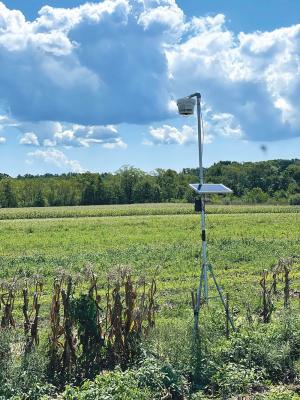2022 - Volume #46, Issue #5, Page #28
[ Sample Stories From This Issue | List of All Stories In This Issue | Print this story
| Read this issue]
Electronic Scarecrow Keeps Sweet Corn Safe
 |
“I’ve been using laser pest deterrents on my farm since 2017,” says Elliot. “Initially, bird damage dropped to less than 1 percent. However, every bird on my farm has grown up on it, and the efficacy has changed marginally.”
Even 5 percent damage is acceptable to Elliot, who suffered an estimated 80 percent loss of his sweet corn crop in 2016. That equated to $18,000 in lost sales. In 2017 he joined a research project with Dr. Rebecca Brown, University of Rhode Island. Brown was looking at laser scarecrow feasibility. It also led to a SARE research grant and the development of DIY scarecrow laser plans.
Since then, Elliot and a partner have been refining and further developing the pest bird repellent system. “Our system is a combination of laser and auditory stimuli that keeps birds uncomfortable and nervous,” says Elliot. “I think it’s the combination of hearing the distress call and seeing the laser at the same time that tricks them into thinking the laser is a predator.”
Elliot suggests that how the mobile system is set up in the field also plays a role. He saturates a block of sweet corn (as much as 2 acres) as it nears maturity and picking, but only for that short period.
“Ideally, I get a unit out to the field as the silk in a block of sweet corn starts drying down,” says Elliot. “When the next block starts drying, I put a system in it. From that point on, I leapfrog systems as blocks are picked out and other blocks near picking.”
Elliot has tried the distress call tape alone and found it to be effective for 5 to 7 days. With the laser, there was no drop in effectiveness.
“I think the number of years we’ve used a laser system has disrupted bird behavior,” says Elliot. “I suspect pecking sweet corn is a learned behavior. They have gone from super organized and highly efficient at destroying corn to having no idea what to do. We still have a lot of birds, but they do almost no damage.”
Elliot and his partner have sold prototype units as they were developed to other market gardeners in a 300-mile area. Feedback has matched Elliot’s success.
“We installed units and trained operators how to use them,” says Elliot. “If there were problems, we serviced them or sent replacement parts.”
Based on what they have learned on the Elliot Farm and that of their cooperators, the partners are taking their system to the next level. The new one is Green Scarecrow 4.0. It includes the laser, the audio system with two speakers, and the solar panel to power them.
“We’re moving from bootstrapping development and reinvesting everything in the system to commercial marketing of the system,” says Elliot. “We’ll move into a fabrication and warehousing facility and begin producing units for sale this coming year.”
Elliot expects most training of operators will be over the phone. The system is a modular design. If a problem develops, it’ll be easy for the operator to swap out a module.
“We expect our system will cost a third of a comparable laser system now on the market,” says Elliot.
He concedes their current system is quite sweet corn specific. The partners don’t plan to stop there. They’re already working on a system for protecting blueberries and other fruit from songbirds.
Contact: FARM SHOW Followup, Ken Elliot, 202 Main St., Lakeville, Mass. 02347 (ph 508-821-0803; Carlton@greenscarecrow.com).

Click here to download page story appeared in.

Click here to read entire issue
To read the rest of this story, download this issue below or click here to register with your account number.




